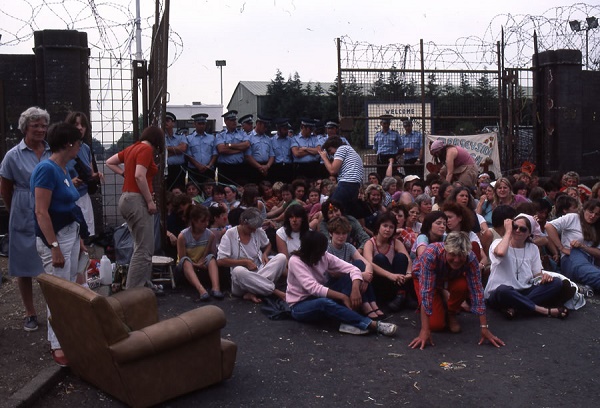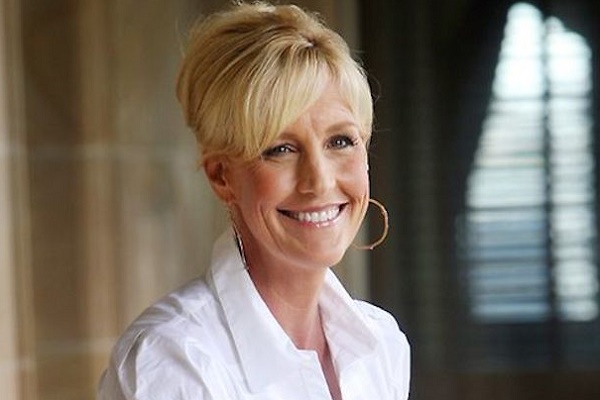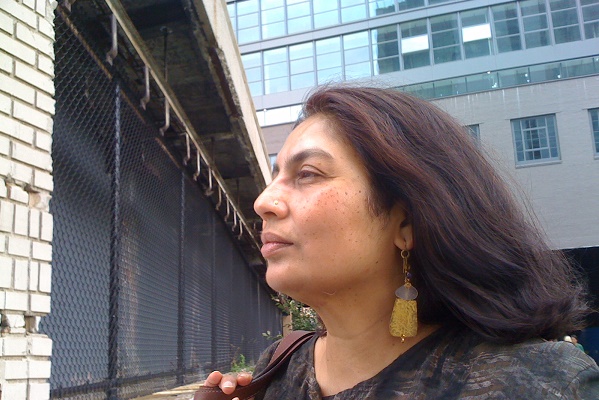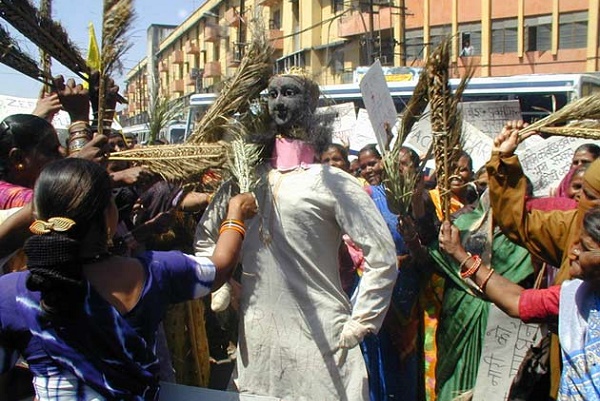It’s 15 years since the disbandment of Greenham Common Peace Camp, the direct action that began one chilly morning in September 1982 when 36 Welsh women activists chained themselves to the fence of Greenham Common RAF base in protest against the nuclear weapons that had been sited there.
The height of the peace camp’s fame had come in April 1983, when 50,000 women formed a 14-mile ‘human chain’ encircling Greenham, RAF Aldermaston and an assembly location for British-made nuclear weapons at Burghfield.

By the mid-80s Greenham Common had given rise to copycat anti-nuclear protest camps across Europe. It was to prove a watershed in post-war protest movements in that it was the first action to mobilise identity politics, in this case second wave feminist identity politics, for the purposes of environmental protest. Although in later years men were admitted to the peace camp precincts (through yellow and violet camps gates; the green gate site remaining strictly women-only until disbandment), throughout Greenham was explicit in mobilising the protestors’ identities as women and mothers to legitimise their protest.
As one early protestor, recorded by Laura Shepherd in her 2010 book Gender Matters in Global Politics, put it: “We were protesting as mothers at the same time as we were making the statement that we would not stay home and do nothing, as women are supposed to, while the men take care of the serious men’s issues.”
In the intervening decades women-led grassroots environmental protests have become a worldwide phenomenon. Sociologist Celene Krauss is author of a paper which explores the early years of women’s environmental protest in the US context: Challenging Power, Toxic Waste Protests and the Politicisation of Working Class Women. She explains that the routine location of polluting and dangerous industries in working class and socially disadvantaged communities fostered, in the 80s and 90s, a new breed of working class woman activists.
The US popular press dubbed these women the Erin Brockoviches, following the story of the Kansas-born beauty queen turned toxic waste campaigner who was immortalised in the saccharine 2000 biopic starring Julia Roberts.

“Worldwide, poor communities are disproportionately chosen as the location of polluting industries and women raising families bear the brunt of this,” Krauss says. “As a result women of diverse racial, ethnic and class backgrounds have assumed the leadership of community environmental struggles around environmental and toxic waste issues.”
Celina Harpe typifies a new, post-Brockovich breed of North American women’s environmental activist. The 79-year old Chipewyan First Nations elder is taking aim against North America's supermajor oil and gas companies, who have polluted the soil and water in the Chipewyana's once-pristine ancestral land in Northern Alberta. Tar sands extraction began in the region in the 1990s in contravention of a First Nations (Canadian Indian) rights ancestral charter. The practice has lead to a spike in cancer rates amongst the Chipewyans, especially rare blood and biliary duct cancers, and has decimated groundwater and fishing stocks.
"Before the pipeline we didn’t know there was such thing as cancer," Harpe recently told a packed conference hall at the Nobel Women’s Initiative’s Breaking Ground Women Oil and Climate Change event. "We had no name for it. Now our traditional way of life is being taken away from us. The river water is polluted. We can't fish, we can't hunt, there are oil camps all over the place... "
Harpe is now one of the most recognisable faces in the campaign against the XL pipeline, the controversial 2010-commissioned oil pipeline system from Alberta to Texas that the tar sands speculation is designed to feed.
To Krauss, the emergence of campaigners such as Harpe highlights that environmental injustice is as much a race as a class issue.
Transnational feminist theorist Chandra Mohanty, in her influential essay Under Western Eyes Revisited, flags up the stark figures: three in five Afro-Americans and Latinos living in the USA live with two miles of a toxic waste site.

"Toxic waste is a pressing issue for marginalised communities," Krauss says. "I wouldn't be surprised if we see many more emboldened women activists from marginalised communities in coming years."
In India, environmental injustice is a caste issue. Amongst the flurry of successful environmental justice campaigns led against the global industry by women leaders from the scheduled (disadvantaged) classes is Rashida Bee of the Jhadoo Maro Dow Ko (Beat Dow with a broom) campaign. In 2004 the activist was awarded the Goldman Environmental Prize for a campaign that mobilised women affected, inter-generationally, by the world's worst industrial disaster (the 1984 Bhopal spillage). In 2003 the women, many of whom had spontaneously aborted on the night of the disaster, or were now unable to bear children after being affected by the chemicals in their childhoods or in vivo, delivered toxic soil and water samples and 500 symbolic brooms to the headquarters of the US headquartered company who owned the factory site at Mumbai.
After 13 years of campaigning, the Delhi labour court passed judgment in Jhadoo Maro Dow Ko's favour, declaring that “regularised” factory workers should be accorded back wages as compensation in addition to the paltry amount offered in the initial settlement. "We danced in the streets to celebrate our victory," Bee told me when I met her a few years ago at Sambhavna, a clinic run for survivors of the disaster in Bhopal. Bee went on to explain the struggle she and fellow campaign heads has to keep their campaign a grassroots, women-led endeavour. "We are just one hundred out of thousands of women still suffering from that night. We have always thought we just have to keep on fighting because we were angry at being victimised. Our personal fight is now global. Even today we don’t feel tired."

Worldwide, women continue to lead the fight against a globalised industrial complex that pursues profit above the physical safety of the world's most marginalised.
In Nigeria this year women from the Rido community in Kaduna took to the streets to protest the chemical waste and fumes from the Kaduna Refining and Petrochemical Company (KRPC) that they claimed were leading to a raise in rates of miscarriage.
In Italy women campaigners are at the head of demands for cleanup of the toxic waste that's routinely dumped by Naples' Camorra crime syndicate.
Meanwhile in the UK, Mothers Against Fracking are, as their Facebook manifesto articulates it: "pulling together to 'baby proof' our water supply and stop greedy and dangerous fracking which releases dangerous chemicals into our precious aquifers."
Can we read the worldwide ascent of the environmental activist as a sign of women’s political enfranchisement? Perhaps, says says Celene Krauss. Yet perhaps it's a sign of something much more interesting; more subversive. "These women have entered the public arena and have overcome barriers to participation shaped by gender, race and class," says Krauss. "In doing so so they frequently invoke motherhood. This is a powerful tactic in that it exposes the hypocrisy of societies that purport to value motherhood and family yet create social policies that routinely undermine these values."
As Krauss and feminist scholars Nancy Naples and Filomina Chioma Steady have shown, women environmental protesters go on to assume positions of political power in their communities after their battles are won. "In speaking out these women overcome resistance from political power and - as my research has shown - resistance to speaking out within their own marriages," says Krauss. "They've found their voice against the odds. They've done with being silenced."